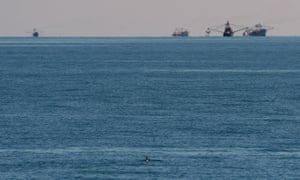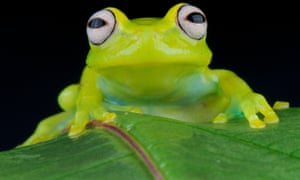Giraffes, sharks, glass frogs - and the woolly mammoth - may get boosted protection at summit
From giraffes to sharks, the world’s endangered species could gain better protection at an international wildlife conference.
The triennial summit of Convention on International Trade in Endangered Species (Cites), that began on Saturday, will tackle disputes over the conservation of great beasts such as elephants and rhinos, as well as cracking down on the exploitation of unheralded but vital species such as sea cucumbers, which clean ocean floors.
Extraordinary creatures being driven to extinction by the exotic pet trade, from glass frogs to star tortoises, may win extra protection from the 183-country conference. It may even see an extinct animal, the woolly mammoth, get safeguards, on the grounds that illegal elephant ivory is sometimes laundered by being labelled as antique mammoth tusks.
Ivonne Higuero, the secretary general of Cites, said: “Cites is a powerful tool for ensuring sustainability and responding to the rapid loss of biodiversity – often called the sixth mass extinction – by preventing and reversing declines in wildlife populations.”
The destruction of nature has reduced wildlife populations by 60% since 1970 and plant extinctions are running at a “frightening” rate, according to scientists. In May, the world’s leading researchers warned that humanity was in jeopardy from the accelerating decline of the planet’s natural life-support systems, which provide the food, clean air and water on which society ultimately depends.The triennial summit of Convention on International Trade in Endangered Species (Cites), that began on Saturday, will tackle disputes over the conservation of great beasts such as elephants and rhinos, as well as cracking down on the exploitation of unheralded but vital species such as sea cucumbers, which clean ocean floors.
Extraordinary creatures being driven to extinction by the exotic pet trade, from glass frogs to star tortoises, may win extra protection from the 183-country conference. It may even see an extinct animal, the woolly mammoth, get safeguards, on the grounds that illegal elephant ivory is sometimes laundered by being labelled as antique mammoth tusks.
Ivonne Higuero, the secretary general of Cites, said: “Cites is a powerful tool for ensuring sustainability and responding to the rapid loss of biodiversity – often called the sixth mass extinction – by preventing and reversing declines in wildlife populations.”

“We do depend on biodiversity,” Higuero said. “It is not just an environmental issue. There are so many species that, if they went extinct, would be sorely missed and we just don’t realise it.”
Matt Collis, the head of the NGO IFAW’s delegation at Cites, said: “Illegal and unsustainable wildlife trade, coupled with habitat loss and other human-made threats, has decimated many species so that they are now at a tipping point for future survival. It is vital that countries come together to do all they can.”
The Cites agreement regulates the international trade in wildlife, from live animals to skins and timber, and unlike other international conventions can punish countries that flout bans by barring them from lucrative markets.
In the run-up to the meeting in Geneva, Switzerland, conservationists have called for sanctions against Mexico, home to the vaquita, a porpoise on the edge of extinction with only about 19 left alive. The vaquita’s demise also illustrates the deadly role of criminals in the destruction of wildlife. The illegal wildlife trade is estimated to be worth $7bn to $23bn a year, ranking only behind drugs, human trafficking and weapons.
“The vaquita is really a poster child for what is happening in terms of international criminal networks and wildlife,” said Higuero. “They use wildlife like drugs, prostitution and arms, because the financial rewards are high.”

The vaquita is killed as bycatch when fishers target the totoaba, a large fish whose swim bladder can sell illegally for $20,000 a kilogram in China because of its supposed medicinal properties.
“People have been killed,” Higuero said. “The [drug] cartels are involved, they are heavily armed and it seems the navy and police can’t control it, so you have a governance crisis.”
She said the area of sea involved was just a quarter of the size of Los Angeles: “If we can’t protect this, what hope is there for anything else?”
Clare Perry, a senior campaigner at the Environmental Investigation Agency, said: “This is the last chance for Cites to spur real action to save the vaquita. [Otherwise] that will be on us, a major extinction on our watch at the hands of criminals.”
Vietnam will also come under pressure, after independent analyses found it was the largest destination for illegal elephant ivory and rhino horn. Margaret Kinnaird, head of global wildlife at the WWF, said: “Vietnam has been of great concern for many years now – much more has to be done.”
Another flashpoint will be opposing proposals on elephants, of which about 20,000 are poached every year for the illegal ivory trade. Southern African countries, home to large populations, want to loosen restrictions to raise funds for conservation. But others on the continent want to make the ivory ban even broader.
Higuero hoped progress might be made by focusing on a goal all the countries share – to improve their citizens’ lives. “[Local communities] want to put food on their tables, education for their children, hospitals and healthcare,” she said. “It is very easy for people from outside to say ‘don’t do this, don’t do that’ but what are the options we can give them so they feel they are gaining something from taking care of nature?”
The most unusual proposal at the summit is to put an extinct species – the woolly mammoth – on the list of species for which trade is restricted. “It would absolutely be the first time,” Higuero said. “The fear is that elephant ivory is being traded as if it were mammoth ivory.”

The summit may also bring good news, with some species being taken off danger lists because their populations are recovering. One, the vicuña, is a relative of the llama and provides extremely valuable wool. Higuero said the prospects of the animal had been improved by getting local communities involved in their conservation. “This is definitely a demonstration of how successful you can be when there are issues of humans and wildlife living side by side,” she added.
A quartet of Australian rodents may also be struck off the list of species in which all trade is banned, for the simple reason that no one wants to buy the greater stick nest rat, the false swamp rat, the central rock rat and the Shark Bay mouse.

No comments:
Post a Comment